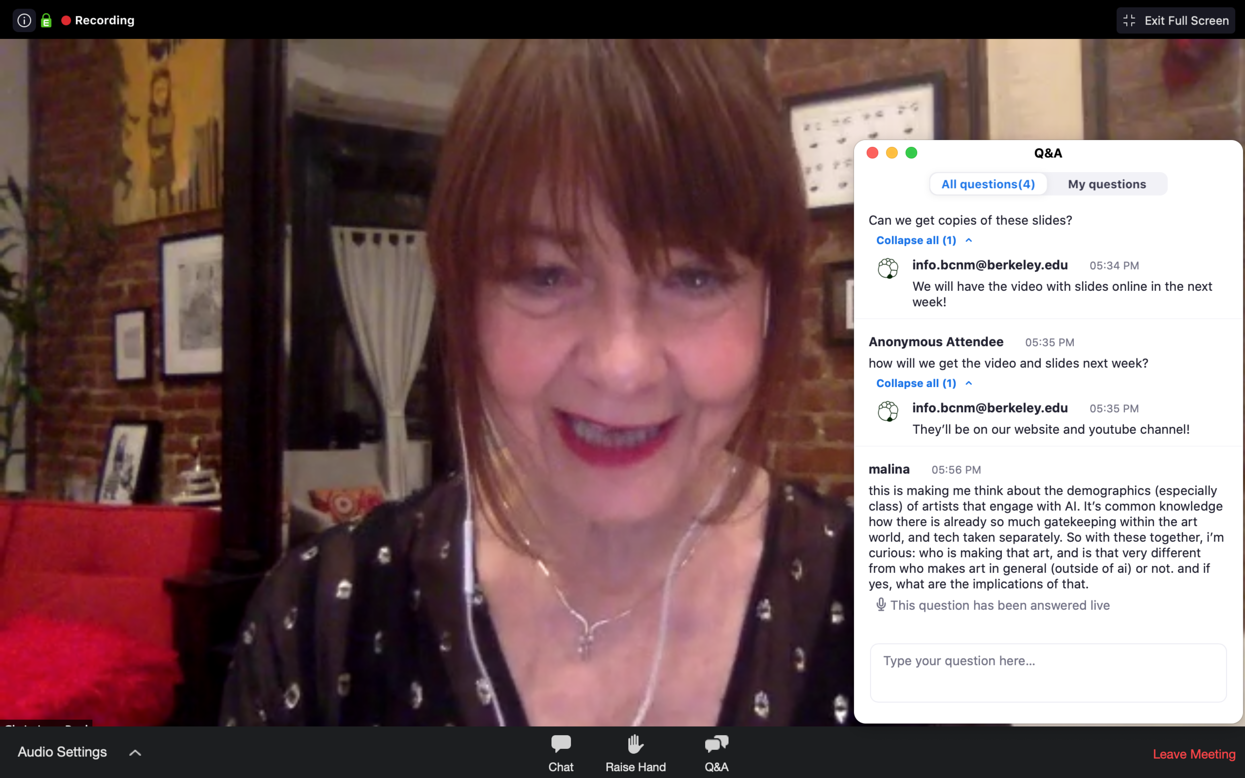HTNM Revisited: Christiane Paul

Recap by Julia Irwin, the 2019-2020 Graduate Liaison for the Art, Technology, and Culture Colloquium.
On Thursday, April 16, digital art curator Christiane Paul joined the Berkeley Center for New Media for a lecture on the ways contemporary artists are engaging with AI. She was joined by contemporary art curator Claudia Schmuckli, who followed the lecture with a response and series of questions.
The concept of artificial intelligence has captured the popular imagination since its inception in the mid-twentieth century. Paul contextualized today’s AI with a set of twin histories—one relating to popular culture and the other to the technology’s phases of development—whose respective influences can be felt in current artworks dealing with the subject. “In pop culture, there is this fear of us being governed by AI robotic overlords, and as always my response to that is, good news, it will never happen the way you see it in the movies and the bad news is, it is already happening, precisely through systems that make decisions impacting your life,” Paul says.
The artists featured in Paul’s latest exhibition The Question of Intelligence are addressing this very problem. While acknowledging the way AI mythologies have established a certain robo-aesthetics, these works largely refrain from fetishizing the technology. Instead, they creatively and playfully address the “bad news” part of Paul’s statement and, in some cases, propose utopian alternatives. In what ways is AI at work in our lives that we can’t see or know? What biases do these automated systems exhibit, as a result of how they were trained? How can we even tell when they are acting out those biases? Can we reimagine these systems altogher? And, more fundamentally, the artworks all investigate the very notion of intelligence and how it is evidenced in both humans and machines.
Artists featured in The Question of Intelligence take a conceptual approach to the topic, but they also engage with AI by employing it as a medium. For example, Stephanie Dinkins’ Not the Only One (N’TOO) (2018) is a voice-interactive AI storyteller, trained on the experiences of three generations of women in Dinkins’ family, including herself. Paul says of the piece, “It is quite a different experience to have a conversation with an AI that is deeply personal,” built from a data set featuring an African American family, a community notoriously underrepresented in the development of AI more broadly. Another piece in the show, Tega Brain’s Deep Swamp (2018) is a triptych of wetland terrariums that are governed by three different AIs, each programmed to exhibit a distinct desire. An AI-connected camera monitors each environment to tweak parameters in the terrarium to achieve its goal—to maintain a natural looking wetland, to produce an artwork, to attract attention through originality, respectively. They do this by attempting to matching the camera feed from the terrarium to the results of online images searches. Brain is asking us to question our relationship to natural environments and the limits of AI-driven optimization.
The event concluded with a lively discussion between Paul and Schmuckli, who also recently curated an exhibition on AI—Uncanny Valley at the De Young Museum in San Francisco. The two discussed how AI has just in the past few years become a subject that many, many artists are turning to, which signals a sense of cultural urgency to acquaint ourselves with this uncanny technology that is all around us but that we often cannot detect. The artists discussed throughout the lecture are finding creative ways to make AI’s influence legible to the human sensorium and translatable to a human kind of intelligence.
